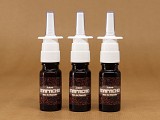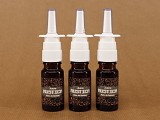Bottle With Sprayer, 11 Ml from Brazil (SKU 3258)
Restock Expected end November. This potent blend of Rapé and Tabaco, enhanced with refreshing aromas of Mint and Cacao, is crafted using advanced high-frequency resonance extraction. Our meticulous process ensures a pure, concentrated liquid that provides immediate and intense effects, promoting deep grounding, enhanced focus, and clarity. Perfect for grounding and cleansing the sinuses, Suco de Rapé Clarity offers a deeply enriching and holistic experience. Detailed information can be read below.
Packed in 11 ml amber glass bottles, nose-spray dispenser included. To prevent leakage, please ensure the sprayer is screwed on tight until it clicks.
Suco de Rapé Clarity - Rapé and Tabaco Nasal Spray
Tabaco juice is a revered traditional medicine among indigenous people, widely utilised by shamans and healers across continents. Traditionally inhaled through the nose from the palm of the hand, we have modernised this ancient practice by delivering the medicine in the form of a nasal spray.
Suco de Rapé Clarity is a powerful liquid extract made from a blend of different varieties of Rapé, and Tabaco such as Rustica and Mapacho. Aromas from the Mint family and Cacao are added in the final process for an invigorating experience.
Our potent liquid Rapé and Tabaco extract called Clarity is administered via a nasal sprayer, a method we have perfected over many years. We proudly present a variety of liquid Rapé and Tabaco nasal sprays, including our powerful Suco de Rapé Clarity, made from a blend of various tribal Rapés and extracted using advanced high-frequency resonance extraction. To learn more about this extraction method, read here. A small percentage of bio alcohol ensures an almost unlimited shelf life.
This potent liquid extract is the result of years of meticulous development and fine-tuning. Our innovative method delivers the traditional benefits of Rapé and Tabaco in a convenient and effective nasal spray.
Suco de Rapé Clarity liquid extract is available in 11 ml amber glass bottles with a nasal spray dispenser. We also offer 22 ml refill bottles (without sprayer). To use, apply one or two sprays in each nostril, holding the sprayer at an angle aimed towards the center of the head. Slightly breathing in through the nose enhances the entry into the sinuses. Treat each nostril separately, as they have distinct properties: the left side expels negative energy while the right side receives positive energy, balance, and health. Allow the fluids to exit by blowing your nose, and spit out any remains rather than swallowing them. It is recommended to keep the body upright and avoid lying down after application.
The distinct aroma and strength of Rapé juice are immediately noticeable, producing a sensory explosion in the center of the face. Rapé juice sharpens focus and presence, providing powerful grounding and silencing mental chatter. It has a profound cleansing effect on the sinuses and opens both the heart and mind.
Our Clarity Nasal Spray, created with advanced high-frequency resonance extraction, represents the forefront of herbal extraction technology. It offers a potent, pure, and versatile product that excels in both quality and innovation, providing users with a deeply grounding and spiritually enriching experience.
Our liquid extract undergoes months of natural settling before being bottled. Even with the finest filtration, the smallest particles can remain in suspension, slowly sinking over time. Due to the extract's high concentration, you may notice sediment forming as active compounds gradually settle out of the solution during storage. To prevent clogging, we recommend storing the bottle on its side and shaking well before each use to redistribute the sediment.
If the sprayer becomes clogged, remove it and submerge the stem in hot water. Pump the sprayer underwater until it flows freely. Afterward, spray a few times outside the water to clear it. Always ensure the sprayer is mounted tightly to prevent leakage.
Disclaimer:
The information provided above is for historical, educational, and scientific purposes only. It should not be interpreted as a recommendation for the specific use of our products. Any statements about traditional uses are informational. The use and application of our products are the customer's decision and responsibility.
Copyright Notice:
All content, including this article, is protected under copyright law. Any unauthorized reproduction, distribution, or use of this material is prohibited. Duplication of this content, in whole or in part, without written consent, is a violation of copyright regulations.
Other names: Fluid Rapé, Rapé juice, liquid Rapé, Rapé liquid extract.
Mapacho is one of the most traditional and most wholesome plants of the Amazon. It is used alone by shamans that specialised in Tabaco (tabaqueros) or it is used in combination with other plants, like Ayahuasca. Another traditional Tabaco use is the use of singa, or Tabaco liquid. Singa is often applied during initiations, crises, and rituals, where it can be snuffed, drunken, or spit over the body of a sick person with according chants. Moreover, singa has sedative or narcotic effects that help to induce a trance state, and in addition, to suck out evil spirits and illnesses in patients.
Shamans that use singa either drink it or snuff the liquid to induce strong visions, like shamans of the Montaña and Guyana region where a Tabaco liquid is taken for magico-religious ceremonies. Yet, every tribe has their own particular ways of using and preparing singa, some mix it with other ritualistic plants, like Ayahuasca or Maikoa (Brugmansia), and in other tribes, like the Coto Indians of Peru, only shamans are allowed to snuff singa, whereas other male tribe members are only allowed to drink the juice. The Jivaro of the Montaña became very sophisticated in drinking and preparing Tabaco juice to envision and to communicate with the earth and its spirits (Grimal 1965). Moreover, the Jivaros drink singa during initiations, vision quests, war preparations, and during witchcraft and even female tribe members are allowed to use singa. The Guyana Indians squeeze and steep the leaves in water. Then the liquid can either be drunken or snuffed, depending on their gender: female tribe members drink, whereas male members tend to inhale the liquid. The Tukanos of Columbia and Brazil use singa only during shamanistic rituals, and apply the liquid solely to shamans or apprentices to cause vomiting and eventually narcosis. Some tribes also boil the Tabaco water down into a concentrate and, sometimes they add a thickened Casava starch to the brew in order to get a thick Tabaco paste. This Tabaco paste is licked from the fingers or from a stick. Either way, the strong liquid brings the user very quickly into somnolence and evokes a strong physical reaction, including trembling, vomiting, and nausea, which is considered indispensable to clean and purify the body and mind.
The shamans in the Ecuadorian Montañas drink Tabaco juice to communicate with the spirit world and they inhale Tabaco water to call the Tabaco spirit and ask for help to treat illnesses and relieve hostile energies or supernatural forces. Tabaco shamans from the Campa, drink concentrated Tabaco juice to communicate with and ask for support of spirits during ecstatic trance states. The Tabaco drink allows the shaman to ease the suffering of sick people and of people that have been attacked by dark shamans or evil spirits. Moreover, tribes like the Jivaros use Tabaco juice for several medicinal purposes, including the treatment of indisposition, chills, pulmonary problems, and snake bites.
Mapacho Tabaco is several times stronger than our usual Tabaco and should be used with caution. It can cause nausea, vomiting, trembling, increased heartrate, and mind-altering effects. Be careful when swallowing the juice, it is highly intoxicating when consumed in high doses!
Schultes, R.E. and R.F. Raffauf. 1995. The Healing Forest: medicinal and toxic plants of the northwest Amazonia,Dioscorides Press, Portland, Or.. ISBN 0-931146-14-3
Wilbert, J. 1987. Tabaco and Shamanism in South America, Yale University Press, New Haven, Conn.
Rubin VC (1975). Cannabis and Culture (World Anthropology). Mouton, the Hague, 1975.
Grimal, Pierre, Larousse World Mythology, Secaucus, New Jersey, Chartwell Books, 1965. p. 483
Ross IA (2005). Medicinal Plants of the World, Volume 3: Chemical Constituents, Traditional and Modern Medicinal Uses. Humana Press. 2001 edition
This item is not allowed in the following countries:
Finland, Japan, Russia
This natural product is offered for its ethnographic and historical value and is delivered with no expressed or implied fitness for a specific purpose. It is simply a raw botanical specimen, or a scientific sample. The information provided is purely meant for historical, scientific and educational purposes and should never be interpreted as a recommendation for a specific use. The use and application of our product is at the customer's decision, responsibility and risk.
Read our Terms & Conditions for more details.








